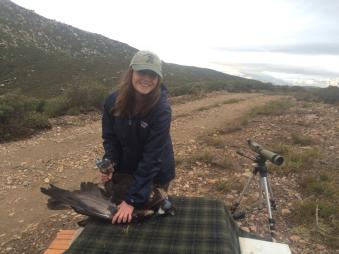-
About
- Leadership & Faculty
- News & Events
-
Academics
- Graduate
- Advanced Clinical Training
- Continuing Education
-
Student Life
-
Research
-
Hospitals & Clinics
- Emergency Care
- Hospital Services
-
Community Outreach
- Volunteer
Searching for Southern California’s Birds of Prey
Tatyana Kalani MCM ‘17

After off-roading through canyons and ridges for miles, I stepped out of the car and looked out at the southeastern California desert from nearly 6000 feet above it. This montane chaparral region had a recent visitor at a baiting carcass: a golden eagle. My mentor, Dr. Peter Bloom, and I set up our net around the carcass, anxious to band the three-day visitor so we could take samples and place a GPS transmitter. Dr. Bloom is a key biologist studying golden eagle population dynamics. Currently, golden eagle abundance is unknown in California, though evidence is pointing to a decline in numbers due to many factors, including lead poisoning.
Catch and Release
After a few hours of waiting two miles away where we were only able to view the carcass through our binoculars, we spotted an eagle at the site and deployed the net. The bird was a nearly 13-pound adult female golden eagle, with no band or identification. We banded her with a unique identification number, placed a GPS transmitter that allows biologists to track an individual’s movements, obtained blood samples for lead testing, and obtained feathers for genetic analysis of the population. Upon completion of the process, I released her and watched her soar back over the ridge.
After a few hours of waiting two miles away where we were only able to view the carcass through our binoculars, we spotted an eagle at the site and deployed the net. The bird was a nearly 13-pound adult female golden eagle, with no band or identification. We banded her with a unique identification number, placed a GPS transmitter that allows biologists to track an individual’s movements, obtained blood samples for lead testing, and obtained feathers for genetic analysis of the population. Upon completion of the process, I released her and watched her soar back over the ridge.
During the next four weeks, I had similarly exciting experiences with different bird species in several locations. We spent time in the mountains, in the desert, in urban locations, and in the coastal sage-scrub, highlighting the diversity of habitat California has to offer. We were looking for everything from small American kestrels and burrowing owls, to larger red-tailed hawks, turkey vultures, and golden eagles. We were often working on projects with various agencies and non-profit organizations, as fieldwork is collaborative by nature.
Practicing field skills
The weather did not always cooperate for us. This winter was particularly rainy in California, a state that has been in a six-year long drought. During my externship, Southern California experienced heavy rain three to five days a week, with three major storms which restricted the amount we were able to accomplish in the field. Muddy roads disrupted our plans and prevented us from trapping. Instead, we focused on building traps, making identification tags, and practicing banding skills. I learned valuable skills during the course of my externship. For example, I was exposed to a variety of trapping and processing techniques, each unique to the species we were working with. Life history characteristics like hunting strategies, body size, and prey type were some factors that influenced our approach. Another skill I learned was proper handling to keep the bird and myself safe. Through my externship, I gained a wide range of skills and knowledge of the field that has allowed me to grow as a scientist, and continue on with me in my future career.
The MCM Program
The externship was part of my course requirements in the Masters in Conservation Medicine (MCM) program, where I am currently a student. The MCM program has fostered an environment that has allowed me to explore my interests and pursue areas I did not have access to before. The courses that I took last semester like “Ecology and Conservation Biology” and “Health, Disease, and the Environment” built a solid foundation of knowledge that I could utilize in my externship. I had opportunities to do a project on anticoagulants, as well as have a guest lecture from Dr. Maureen Murray who studies this exact topic at the Wildlife Clinic, both of which increased my interest in the field and contributed to my pursuit of this externship.
Why Birds of Prey?
I became interested in birds of prey during my time in undergraduate school after volunteering for many years at the California Raptor Center. I found the life history strategies of these birds extremely intriguing, with their strong talons, heightened eyesight, and hooked beaks. Due to their place in the food chain, poisoning such as rodenticides and lead threatens this group of birds, along with other factors like habitat loss. Anticoagulant rodenticides and lead poisoning are not only threats to raptors, but to our domestic animals and us. Conservation efforts to protect these birds are very important to me, and I wanted to learn more about how I could work with raptors in the future to help mitigate the problems associated with poisoning.


